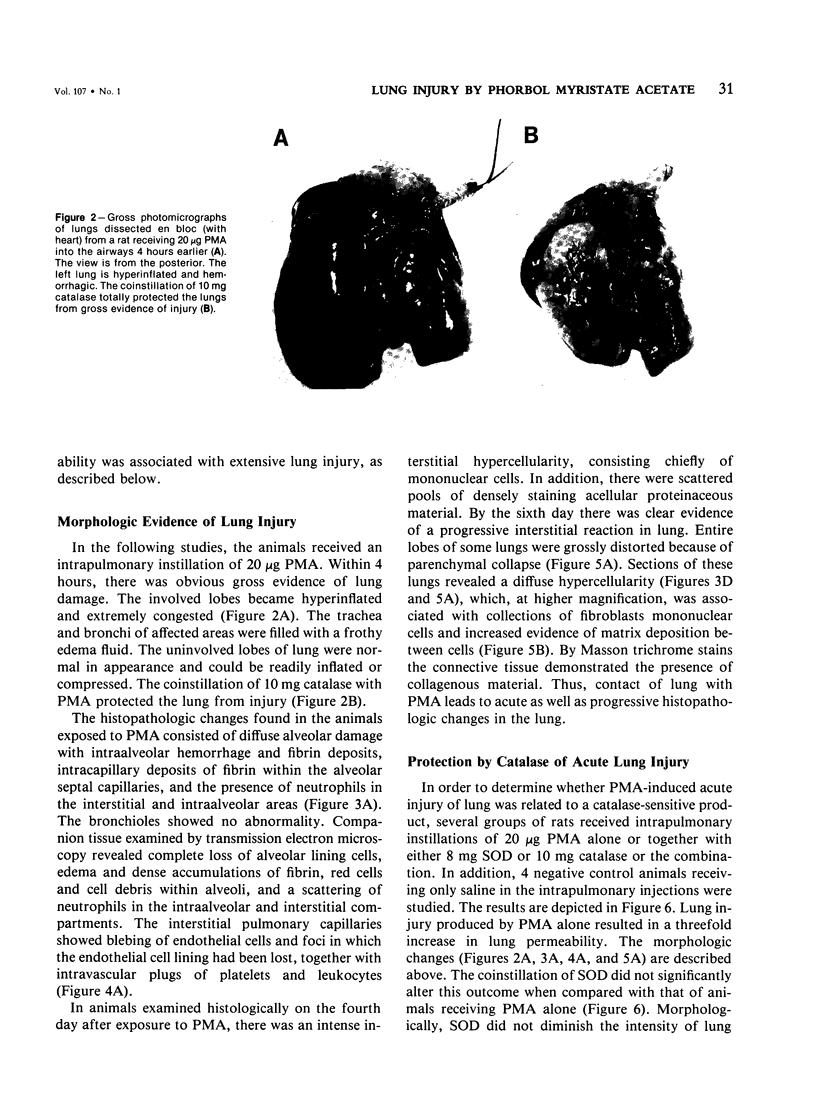Abstract
Because of its potent ability to activate leukocytes and macrophages, resulting in the generation of large amounts of oxygen products (O-2, H2O2), phorbol myristate acetate (PMA) has been instilled into the air-ways of rats. The resulting acute lung injury is dose-dependent on the amount of PMA employed, is chiefly confined anatomically to the alveolar and interstitial compartments, is neutrophil-independent, and can be inhibited by catalase but not by superoxide dismutase. These data suggest that the generation of H2O2 is major mechanism involved in this method of acute lung injury. It has also been demonstrated that a progressive pattern of lung injury develops after exposure to PMA, with the onset of an interstitial fibrotic reaction by the sixth day. These data reinforce our recent studies, in which both acute and progressive injury occurs in lungs of rats when H2O2 is generated.
Full text
PDF






Images in this article
Selected References
These references are in PubMed. This may not be the complete list of references from this article.
- Burk R. F., Lawrence R. A., Lane J. M. Liver necrosis and lipid peroxidation in the rat as the result of paraquat and diquat administration. Effect of selenium deficiency. J Clin Invest. 1980 May;65(5):1024–1031. doi: 10.1172/JCI109754. [DOI] [PMC free article] [PubMed] [Google Scholar]
- Forman H. J., Nelson J., Fisher A. B. Rat alveolar macrophages require NADPH for superoxide production in the respiratory burst. Effect of NADPH depletion by paraquat. J Biol Chem. 1980 Oct 25;255(20):9879–9883. [PubMed] [Google Scholar]
- Johnson K. J., Fantone J. C., 3rd, Kaplan J., Ward P. A. In vivo damage of rat lungs by oxygen metabolites. J Clin Invest. 1981 Apr;67(4):983–993. doi: 10.1172/JCI110149. [DOI] [PMC free article] [PubMed] [Google Scholar]
- Johnson K. J., Ward P. A. Acute immunologic pulmonary alveolitis. J Clin Invest. 1974 Aug;54(2):349–357. doi: 10.1172/JCI107770. [DOI] [PMC free article] [PubMed] [Google Scholar]
- Johnson K. J., Ward P. A. Role of oxygen metabolites in immune complex injury of lung. J Immunol. 1981 Jun;126(6):2365–2369. [PubMed] [Google Scholar]
- Kaneda M., Kakinuma K., Yamaguchi T., Shimada K. Comparative studies on alveolar macrophages and polymorphonuclear leukocytes. II. The ability of guinea pig alveolar macrophages to produce H2O2. J Biochem. 1980 Oct;88(4):1159–1165. doi: 10.1093/oxfordjournals.jbchem.a133070. [DOI] [PubMed] [Google Scholar]
- Lin P. S., Kwock L., Goodchild N. T. Copper chelator enhancement of bleomycin cytotoxicity. Cancer. 1980 Dec 1;46(11):2360–2364. doi: 10.1002/1097-0142(19801201)46:11<2360::aid-cncr2820461108>3.0.co;2-a. [DOI] [PubMed] [Google Scholar]
- McCormick J. R., Harkin M. M., Johnson K. J., Ward P. A. Suppression by superoxide dismutase of immune-complex--induced pulmonary alveolitis and dermal inflammation. Am J Pathol. 1981 Jan;102(1):55–61. [PMC free article] [PubMed] [Google Scholar]
- McPhail L. C., DeChatelet L. R., Johnston R. B., Jr Generation of chemiluminescence by a particulate fraction isolated from human neutrophils. Analysis of molecular events. J Clin Invest. 1979 Apr;63(4):648–655. doi: 10.1172/JCI109347. [DOI] [PMC free article] [PubMed] [Google Scholar]
- Shoyab M., Todaro G. J. Specific high affinity cell membrane receptors for biologically active phorbol and ingenol esters. Nature. 1980 Dec 4;288(5790):451–455. doi: 10.1038/288451a0. [DOI] [PubMed] [Google Scholar]
- Weiss S. J., LoBuglio A. F., Kessler H. B. Oxidative mechanisms of monocyte-mediated cytotoxicity. Proc Natl Acad Sci U S A. 1980 Jan;77(1):584–587. doi: 10.1073/pnas.77.1.584. [DOI] [PMC free article] [PubMed] [Google Scholar]






